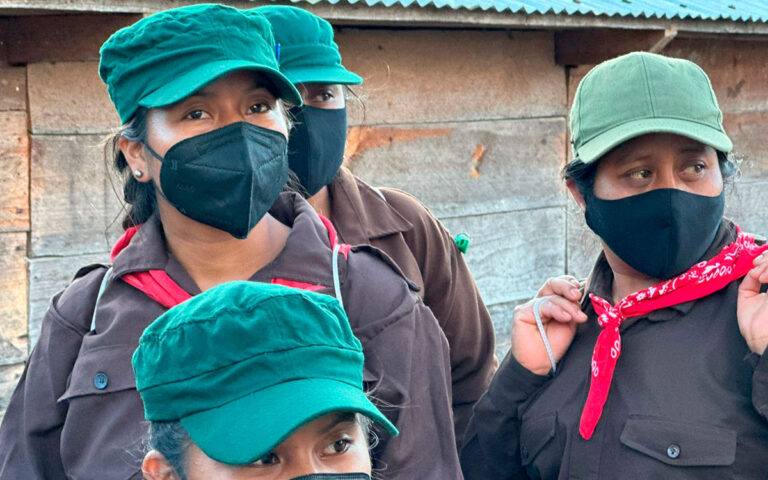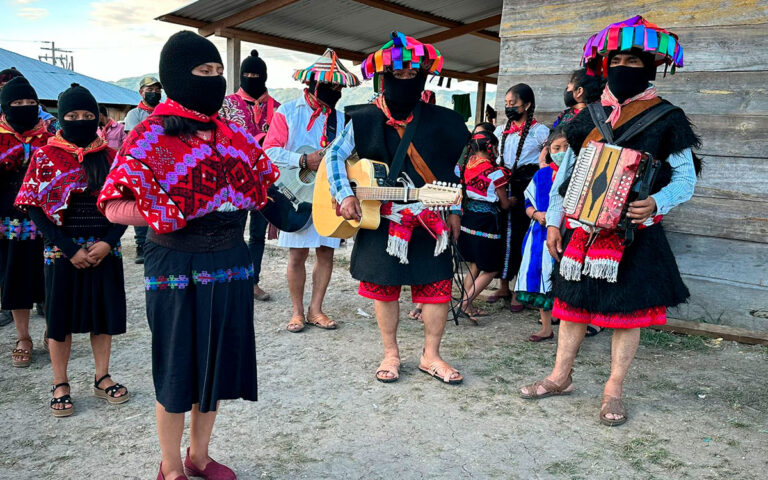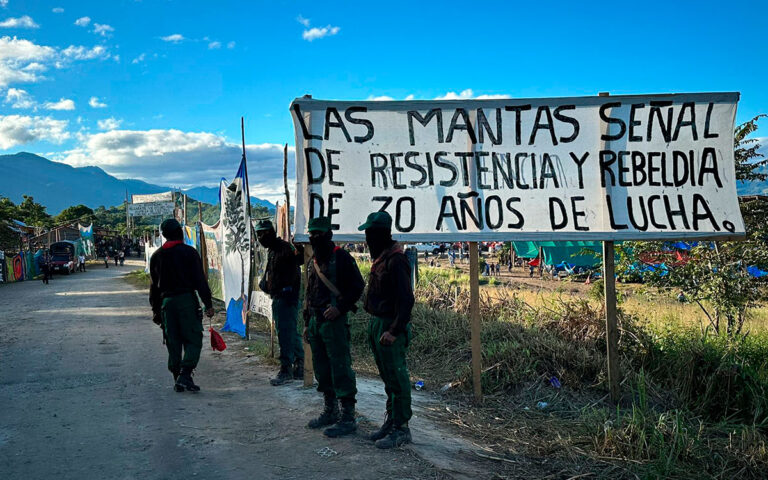
”Property must be the people’s and common and the people must govern themselves,” said Sub-commander and spokesperson of the movement, Moisés.
Ángeles Máriscal
How has the Zapatista Army of National Liberation (EZLN) movement survived in the 30 years since it declared war on the Mexican government? Do the Zapatistas exist? They have they done? What has changed? What do they propose now?
Journalists from several countries and media outlets arrived at the Dolores Hidalgo community, located in the municipality of Ocosingo, in the Las Cañadas area, hoping to see a spectacular display and an extraordinary speech from the indigenous armed movement that challenges the governments of Mexico and the world.

They found simple people, thousands of young people especially, women and men, some in brown and green uniforms, who continue carrying as weapons – as they did on January 1st, 1994 – two wooden sticks. They found that, instead of a militarized display, they marched to the rhythm of cumbia music.
They found a large dirt esplanade as a setting, some wooden buildings converted into collective dormitories, a kitchen, and a health center. And through political discourse they heard plain words, first in Tseltal and then in Spanish, which above all invited them to see the signs of the reality resulting from the economic system imposed by the governments of the world.
Some journalists left disappointed at having had to travel hundreds of kilometers to this place, of country roads, of wooden houses, of simple and peaceful people who would possibly lose in an armed war in a few hours.
Here there are no war tanks, there are no militarized installations, there are no bunkers; nor are there the elements that the capitalist development model imposes as desirable parameters, and that basically mark what is considered poverty or wealth.
Here there are no luxury cars, there are no houses with two or more floors, there is not even private property and that is the choice: not living in accordance with the system of capitalist development that has been imposed for five centuries throughout the world, that imposes the accumulation of goods, individual work, and that has left millions of people without land to feed themselves, migrating; in addition to devastated ecosystems.
So, if the questions of how many there are and what their achievements are are answered with the parameters imposed by the capitalist development system, the answer is that they are few, they are still poor and they do not have the capacity to win an armed war.
But if the question is how, being “poor and few”, they have survived 30 years, and how they continue to be the reference that attracts journalists from all over the world, intellectuals from all over the world – also present at the 30th anniversary celebration – and activists from all over the world – also attendees at the celebration -; it is because the Zapatista people decided to live in building in a non-capitalist way, in a process that has had ups and downs, inconsistencies, incongruities, and that continues to be worked on politically and in daily life.
The 30th anniversary celebration took place on the recovered land of what is now known as Dolores Hidalgo, a land taken in 1994 from the landlords who for centuries became rich from the exploitation of the native peoples, where the grandparents, great-grandparents and great-great-grandparents of the young people present today lived in a situation of semi-slavery.
At the celebration there was collective food that did not need to be paid for, although for those who still wanted more food, there were dining rooms where they could buy something extra. The beef that was served was raised in community, belonged to everyone and was shared with the invited people.
In the political-cultural program until January 2nd, everyone participated; there were plays, songs, exhibitions of paintings, and in all of them they explained that capitalism has left dispossession and violence in communities.
In a play, young people represented this violence, the most recent being that of organized crime that impacts on their communities and about which they denounce the complicity of state institutions with these groups.

They also represented the destruction and dispossession of their territories by projects such as the trans-isthmus train, the Mayan train, and mining.
They proposed, through plays, their own process since their creation as EZLN, in 1983, the armed uprising of 1994 and, its commitment to the construction of new forms of life and self-government, and its commitment to communal work as a pillar of the collective that continues to be in the process of construction.
Almost at midnight, a statement was made by the Sub-commander and spokesman of the movement, Moisés, that began by remembering the mothers and fathers searching for missing persons, the thousands of disappeared due to violence, the political prisoners, the murdered people.
Below the small structure that served as a stage, they placed an altar where there were photographs of Commander Ramona, Commander Pedro and each Zapatista who had fallen during these years.
“Our grandparents who fought more than 500 years ago are also gone. Our fallen comrades who have already done their duty. We are here today not to remember the fall of these compañeros from 40 years ago, from 30 years ago, here we are here, fellow Zapatista compañeros, so that we keep in mind the duty, because it was a duty to those companions,” said the spokesman for the movement.
Moisés questioned the analyzes and criticisms that some academic sectors have made of the Zapatista movement. “We don’t need them to come and give us an explanation or a political class or workshop about how the system is. So simple and you simply see how the capitalist system is (…) Why do we want to take classes on that, it is simple to see.”
He stated that in this scenario, the EZLN’s commitment for the coming years, community construction, “there are two things here: the property must belong to the people and be common, and the people must govern themselves.”
“The people are the ones who have to know how to govern themselves, Zapatista compañeros. That is what we demonstrated 30 years ago (…) we have to do it in practice, we do not have a manual, we do not have a book.”
“There is no book that we are going to find where we can find this, the book is the one that you showed here from our great-grandparents and our great-great-grandparents, that is the common book.”
Moisés explained that they are in a constant process of sharing ideas “to see which one is the best for life.” What is already a fact – he said – in practice, “whoever works eats, whoever does not work should eat his bills and eat his coins, to see if that satisfies his need for hunger.
He announced that in the coming years they will work on strengthening “communality,” which is not the same as collective property, but rather non-ownership, “but for that you need organization, doing things in deeds.”
He explained that the process they are in does not require the use of weapons, but that if the Zapatista peoples are attacked, “we are going to defend ourselves.” “We are going to follow that path and we are going to defend ourselves. We don’t need to kill soldiers and bad governments, but if they come, we will defend ourselves.
“This is what we are going to be doing throughout these years. The people rule and the government obeys, the means of production are common and it is the people who will see it. Thank you very much, that’s all our word.”

In the days prior to the celebration, the EZLN explained through several communiqués that as part of the restructuring processes, the Good Government Councils that operated regionally were disappearing, creating new Local Autonomous Governments (GAL) that have the capacity to take decisions regarding their alliances with other peoples, even with non-Zapatistas, and that in these local governments there was also the decision to implement defense actions against threats, among them those of organized crime groups.
Original article published by Aristegui Noticias on January 2, 2023. http://tinyurl.com/2dtvs9vx
Translated by Schools for Chiapas.
